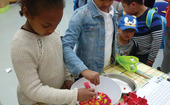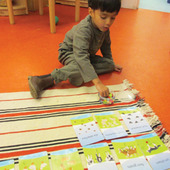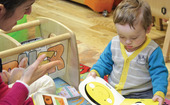British parents. Annette Rawstrone explores the advantages of the
model.

Half the world's 1.9 billion children are bilingual. Education in more than one language is the norm in countries such as Canada, where 12 per cent of the population is in fact trilingual, speaking a language other than English or French at home. Sadly, the UK lags far behind its European counterparts in terms of language skills and, as a result, early years entrepreneurs are increasingly seeing the potential of opening settings here. While they agree that, from a business perspective, it gives them a unique selling point, there is also a common, passionately held belief in the advantages of teaching children additional languages at a young age (see box).
 The majority of bilingual nurseries are in London, which Katja Ting, principal of Little Trees in Barnet, North London, attributes to the large number of international families living in the city. She moved to London from Taiwan and opened a Chinese school in 2001 primarily to serve the Chinese community. Local demand from parents led to her offering places to non-Chinese families and then, last year, the bilingual Mandarin-English nursery opened. Around 80 per cent of the children who attend the setting are from non-Chinese backgrounds. Ms Ting has received enquiries from parents living in other areas of the country and believes there is interest in establishing settings that offer other languages outside of London.
The majority of bilingual nurseries are in London, which Katja Ting, principal of Little Trees in Barnet, North London, attributes to the large number of international families living in the city. She moved to London from Taiwan and opened a Chinese school in 2001 primarily to serve the Chinese community. Local demand from parents led to her offering places to non-Chinese families and then, last year, the bilingual Mandarin-English nursery opened. Around 80 per cent of the children who attend the setting are from non-Chinese backgrounds. Ms Ting has received enquiries from parents living in other areas of the country and believes there is interest in establishing settings that offer other languages outside of London.
Research shows that the brain has a critical window for language development up to the age of four, when it is most plastic. Ms Ting says the crucial time is from birth to three, when children are starting to learn their first language. 'If children learn a language from a very young age then they learn to speak it like a native speaker,' she explains.
Margarita Morro Beltran, who launched the Peques Anglo-Spanish nursery chain, says British parents are increasingly regarding bilingualism as important. She began in 1999 with two settings in Fulham, London, and one in East Grinstead, West Sussex, after moving to England with her family from Spain. Spanish and English are spoken in her three settings and she introduced Mandarin into one of the nurseries in 2008 because she saw it as 'the language of the future', with China now a superpower and developing a role as a world leader. 'Years ago it was believed that if you spoke English then you didn't need another language, but now that's not the case,' says Ms Beltran. 'I find that parents are much more open to their children speaking different languages.'
Philippe Fraser, director of Bilingual Nurseries, which has three settings in London, started with a monolingual nursery in 2008 that he turned into a bilingual French-English setting. He thought the setting would appeal to 'pushy parents' who wanted their children to achieve academically from a young age, but has been surprised to find that they are more 'open-minded and bohemian'.
He adds, 'Most of our families have a French speaker but, because we're in London, there are many nationalities attending, from Chinese to Norwegian. The appeal is often the social element, such as their children being able to speak to their grandparents.'
In practice
 Opening a bilingual nursery is not an easy option, with Mr Fraser cautioning that 'everything becomes more difficult'. Potential owners need to research what they are offering carefully and not overlook the core business principles that are needed when opening any new setting, such as the location and quality of care. 'Parents get excited at the prospect of their children learning other languages but, as with any business, the most important thing is location,' says Ms Beltran. 'Parents enrol with us because of the convenient location and loving atmosphere, rather than the language.'
Opening a bilingual nursery is not an easy option, with Mr Fraser cautioning that 'everything becomes more difficult'. Potential owners need to research what they are offering carefully and not overlook the core business principles that are needed when opening any new setting, such as the location and quality of care. 'Parents get excited at the prospect of their children learning other languages but, as with any business, the most important thing is location,' says Ms Beltran. 'Parents enrol with us because of the convenient location and loving atmosphere, rather than the language.'
A common problem for owners of multilingual nurseries is recruiting qualified staff who also have the relevant language skills. 'They need to be able to speak the particular language to a high level but also be able to pass Ofsted in English and, on top of that, have a qualification in childcare,' says Mr Fraser. 'You are looking for quite a combination of factors.' He finds it easiest to recruit from overseas, but that can bring its own problems, such as different cultural expectations; many European nurseries have longer holidays, for example - a practice that can be difficult to integrate here. Also, Mr Fraser often has to pay staff from overseas higher salaries.
Ms Ting agrees that staffing costs are higher, making it more expensive to run a bilingual nursery. 'We did careful market research before opening the nursery to find out how much other local nurseries charge, so that we are not priced too much higher, but we are constantly looking at our fee structure. Thankfully, parents are prepared to pay more for us being bilingual,' she says.
Peques will employ only native speakers because their intonation, tone of voice, expressions and mannerisms are authentic. 'Getting to know a different culture is not something that can be taught. The children get a feel for it from the person; it is all of them, not just the language,' explains Ms Beltran.
Deciding on the nursery curriculum and planning can also be difficult. 'We are inspected by Ofsted and have to follow the EYFS while also feeding in different aspects of Chinese education,' says Ms Ting. 'We are not only teaching the language but also the culture, behaviour, politeness and discipline.' Two of Mr Fraser's bilingual settings follow the EYFS, while the third feeds into a French school so it follows the French curriculum.
Learning through exposure
When it comes to how the children learn additional languages, the nursery owners agree that it should be through play, rather than actual lessons. English is used for running the business, interacting with parents and between the staff, but practitioners use only their native language with the children - known as the one-person, one-language system. 'This is absolutely key,' says Mr Fraser. 'If you don't do this then you don't know what you're doing. Children need consistency because they build relationships through language, and if you mess with the language then you mess with the bond.'
He employs an even split between English and French speakers in his settings so that both languages are provided equally. 'There is more work because children are exposed to a range of activities in both languages and we do not want to repeat them, so planning is much more detailed. Observations are key but it can be tricky to observe in two languages. We need to provide the right level of development for each child but also make sure that activities are accessible in each language. It takes skill and planning, and weekly meetings can't be missed,' says Mr Fraser.
Ms Ting says learning through experience is a 'gentle approach', with children being exposed to the different languages across the curriculum. 'We will not force the production of language,' she says. 'Children may sing songs in Mandarin but not use words (in conversation) for some time even though they understand them. When they do speak, they can say a lot.'
 Ms Beltran says some children display more aptitude for speaking the languages than others. 'It depends on the child, how many days they attend and what languages are spoken at home, but many move on to school being able to speak two if not three languages. An Indian girl attended and, when she left for school, her Spanish was impeccable.' In 15 years she has only encountered two children who refused to speak in a different language and she believes even they will grow up having the ability to pick up languages more easily.
Ms Beltran says some children display more aptitude for speaking the languages than others. 'It depends on the child, how many days they attend and what languages are spoken at home, but many move on to school being able to speak two if not three languages. An Indian girl attended and, when she left for school, her Spanish was impeccable.' In 15 years she has only encountered two children who refused to speak in a different language and she believes even they will grow up having the ability to pick up languages more easily.
Children entering a bilingual nursery may have no former knowledge of the other language, but Ms Beltran says this does not impede communication with staff or their care. 'Children below the age of five understand the language of love,' she says. 'It does not matter what the words are; when someone is caring and speaks to them, they feel comforted.'
BENEFITS OF ATTENDING A BILINGUAL SETTING INCLUDE:
- Acquiring languages with more ease - more likely to develop a 'native-like' ability if taught young
- Being more likely to succeed in learning new languages later in life, even if the original language is forgotten
- Being able to communicate with a wider variety of people through an enriched cultural experience
- More potential job opportunities as an adult
- A proven link with increased cognitive ability.









